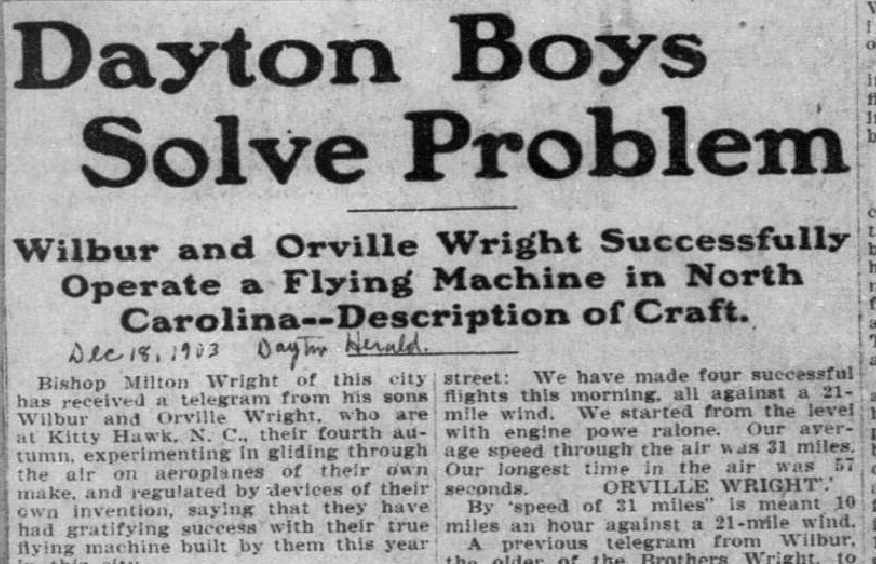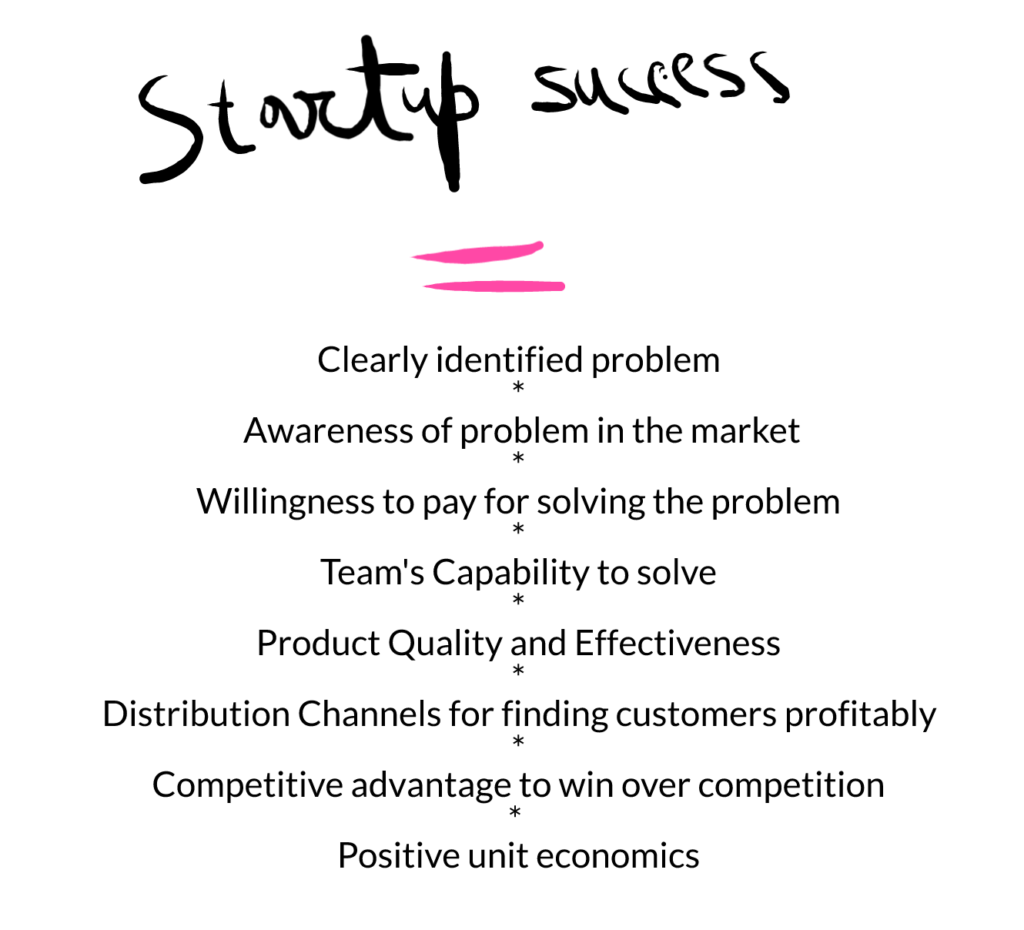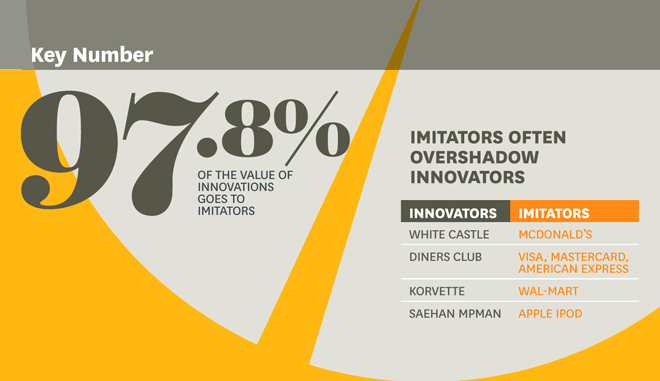No man’s an island and, as a corollary, no startup is truly unique. Media oversells us the virtue of breakthrough ideas. Journalists are paid to highlighting what’s new and noteworthy. Imagine the number of clicks an article would get if it was titled: ‘Here’s the nth example of a Chinese firm copying what’s working in the west’.
To catch our attention, publications run stories that celebrate innovations.

The invention of the airplane was definitely a breakthrough moment for humanity and the Wright brothers deserve all the fame they got. But economically they didn’t do as well as Boeings and Airbuses of the world. Wright brothers knew it themselves that they’re never going to make money from what they were doing. In a conversation with their biographer, Orville Wright said:
“If we had been interested in invention with the idea of profit, we most assuredly would have tried something in which the chances for success were brighter. You see, we did not expect in the beginning to go beyond gliding”
Startup success is like solving a multi variable equation
There’s nothing inherently bad with pursuing truly innovative ideas. What’s bad is pursuing that path with the intent of making money. (There’s a reason why librarians make money than scientists). If you’re a tinkerer or an explorer, go ahead and innovate to your heart’s glee. But if you’re a startup founder, you’re in the business of making money and being innovative might work against your objectives.
Visualize startups solving a multi variable equation and the solution to this equation is a fast growing business.

In the model above, I’ve condensed many factors into a few variables but in reality there’s so much more that has to go right for a startup that it shouldn’t be surprising that most startups fail. For a startup to succeed, metaphorical stars have to align perfectly.
And more variables you tweak, the more likely that you’ll fail in solving the entire equation. This is because all these variables are dependent on each other. Startup success is like a jigsaw puzzle where one missing piece spoils the joy and two or more missing pieces is a horror.
The problem with innovation and what copying solves
When you’re innovating, you’re juggling with most of the balls up in the air. If you were one the Wright brothers, your problem space is somewhat known: people really do want to travel. But everything else is unknown. You have no idea of product’s efficacy (will people fear being up in the air?), you have no idea about unit economics (can we make it profitable?), you have no idea of distribution channels (how to profitably reach to customers who most need air travel?), you have no idea of competitive advantage (what benefits should we focus on to compete with cars and railways?).
It doesn’t matter whether you get most of the answers right, because if there’s one answer wrong, you may burn all your funding or patience before seeing any commercial success
So, why not simply copy instead? Tell me.
Copying is wonderful because it gives you evidence and clues for a solution to the startup multi variable equation exists. It allows you to let other entrepreneurs make mistakes in solving the equation and save you time and effort.
I’m not alone in my observation that copying rocks. Check out this graphic from the HBR article: imitation is more valuable than innovation.

I recommend reading the original article but the gist is in this line: “Today’s lions are the descendants of copycats.”
Successful copycats are smart
When I started VWO, it wasn’t the first web A/B testing tool (Google Website Optimizer was, VWO’s differentiation was in making A/B testing easy). Then, when I started PushCrew, it wasn’t the first web push notifications tool (OneSignal and Roost were there in the market, PushCrew’s differentiation was focus on midmarket). In contrast, whenever I tried innovating, coming up with breakthrough products they failed (read through postmortems of our ‘innovative’ products here and here).
We all know iPhone wasn’t the first smart phone, neither was Google the first search engine, nor Facebook the first social network.
Of course, you know that being first in the market means little if you’re in the wrong market (you knew that right?). But what’s important to note is what copying alone doesn’t guarantee success. There are smart copycats and then there are dumb ones (tip: you want to be the former).
Smart copycats know the value of timing in the market. As a market evolves, you want to enter into it early when it’s nascent and growing. Enter the search market today by copying Google, and you’re going to be crushed. This lesson was learned by Cuil that raised $33m in 2008 to compete in search market and failed miserably. As Peter Thiel says, be the last the monopolize the market. I’ll add my caveat: also don’t be the first to innovate.
When you’re copying, you can’t do surface level copying – you have to commit yourself to understand why a new and emerging category is growing like wildfire and what you can do to beat existing players in your discovered market. Having a strong differentiation over existing players is important, but my fear is that differentiation is a highly misunderstood word. Just because Google differentiated from AltaVista through their PageRank algorithm, it doesn’t mean that differentiation can only happen via technology In Facebook’s case, differentiation was done by limiting signups to the Harvard campus only.
Similarly, you can differentiate by taking the same idea and tweaking one variable in the startup success equation. Perhaps explore the same idea in a slightly different market, or introduce it at a different price point, or reach the growing market via a new distribution channel. Instagram’s copying of Snapchat stories is a perfect example of successful copying. They copied a feature that teens on Snapchat loved and exposed it to their audience (many of whom had never used it before). Bringing a great feature to millions of users is indeed creating new positive value in the world. We entrepreneurs see the act as copying, users see it as their life becoming better.
On the subject of copying, Instagram’s VP of product said: “this is how the tech industry works”. If a billion dollar company is shameless about copying, why you – my dear entrepreneur – are hell bent on innovating?
To make how to copy clearer, let me quote Prof. Oded Shenker from the HBR article that I linked above.
Good imitators don’t wait; they actively search for ideas worth copying. And they often look far from their industry or home country. They also don’t just copy an idea, they come up with a cheaper or better—increasingly it’s cheaper and better—mousetrap. They disrupt the innovator, whose costs are higher by a third, on average, and who’s still sinking investments into the innovation while the imitators are building an offering based on the market reaction to it.
Don’t be afraid of copying, you can’t copy perfectly anyway
Copying is definitely not the most positive word that our society uses to describe human actions, so when we’re copying, we always try to differentiate in some way. If your neighbor buys a new BMW, you’ll probably buy an Audi (or the same BMW, but a better variant).
So my recommendation is to you would be to to copy unashamedly. (I’m not a lawyer, so make sure you’re not violating any patents or copyrights.) Rest assured that in the process of copying, you’ll inevitably add your own personality and you’ll use your life and work experience – you can’t help it but make the copied product uniquely yours.
Perfect copies don’t exist. And in fact, perfect innovation also doesn’t exist. Everything new is built on top of something existing. All I’m urging you to do is to lower your thresholds of originality.
Tips on finding copyable ideas
My advice on how to find new startup ideas in 1 tweet: copy a business that’s growing (such that portion of new customers come to you) or discover a business in an established industry that you can improve by 2x or more (such that existing ones switch to you).
When you’re copying, don’t look for which company got funding (VCs take multiple bets for few successes, so their average bet is usually wrong). To get good ideas, look for companies that are growing like wildfire in terms of customers or users. For B2B, you can go to 3rd party review sites (like G2Crowd or TrustRadius) and see which ones are getting lots of reviews (pay attention to negative reviews). You can go to LinkedIn and see which company is hiring a lot. You can check out Inc 5000 and go through the list of fastest growing companies. For B2C, you can check out AppAnie or SensorTower (they list top grossing apps). Don’t reply on company acquisitions (most of them fail) or new feature announcements (you don’t know whether they’ll work). You have to take the customer view and notice patterns of what they like or dislike.
Summing it up
To be successful, copy what’s already successful in a nascent market and tweak it just so slightly that you’re differentiated in some meaningful way. (And, yes, you can send me your dollars of gratitude if you succeed following my advice).
That’s all folks!
Join 200k followers
Follow @paraschopra